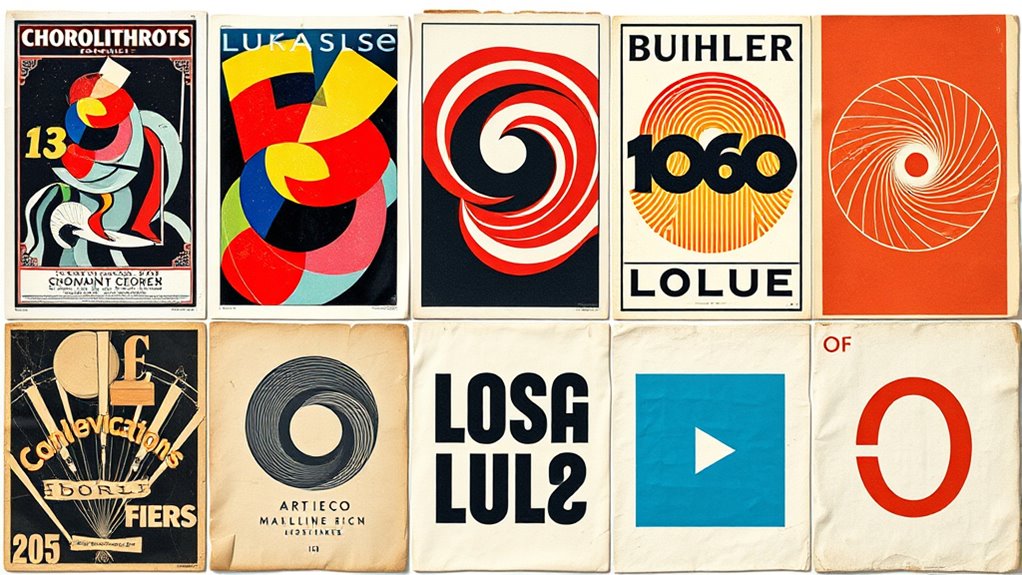The history of graphic design unfolds through ten key milestones that showcase its evolution from primitive cave paintings and symbols to modern digital interfaces. You’ll see how the invention of the printing press revolutionized mass communication, how movements like Art Nouveau and Bauhaus shaped aesthetics, and how branding, typography, and logo design transformed visual expression. The rise of web and social media changed how we communicate visually, hinting at exciting future trends you can explore further.
Key Takeaways
- Primitive symbols and cave paintings laid the foundation for visual storytelling and early communication systems.
- The invention of the printing press enabled mass production of images and text, revolutionizing graphic dissemination.
- The Bauhaus movement introduced modernist principles emphasizing simplicity, functionality, and geometric design in the early 20th century.
- The digital revolution transformed graphic design with tools like Adobe Photoshop and Illustrator, streamlining creativity and collaboration.
- Contemporary trends include mobile-first design, social media visuals, and emerging technologies like augmented reality and generative art.
The Dawn of Visual Communication: Cave Paintings and Early Symbols
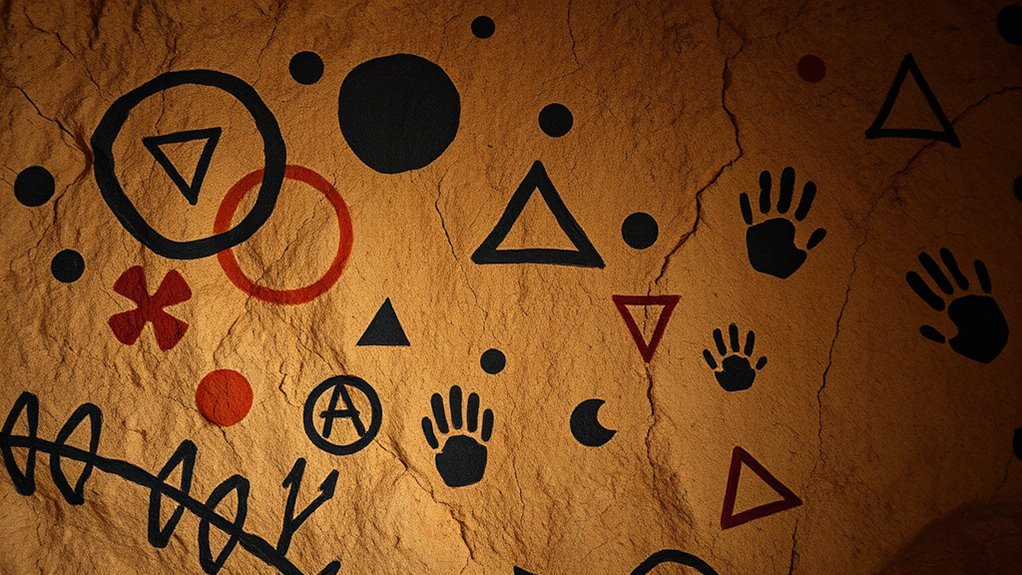
Long before modern design, early humans communicated through images. Primitive symbols and cave paintings served as their primary tools for sharing stories, recording events, and expressing ideas. These early forms of visual communication helped groups coordinate hunts, mark territory, and pass down knowledge across generations. Cave paintings, found in caves like Chauvet and Lascaux, depict animals, human figures, and abstract symbols, revealing their desire to connect with their environment and each other. Primitive symbols often conveyed specific meanings, acting as a visual language that transcended spoken words. These early artworks demonstrate humanity’s innate drive to communicate visually, laying the foundation for all future graphic expressions. Their simplicity and symbolic power continue to influence visual storytelling today. Additionally, the development of early writing systems marked a significant milestone in transforming visual symbols into more complex forms of communication.
The Invention of the Printing Press and the Rise of Reproducible Graphics

The invention of the printing press in the 15th century revolutionized graphic design by enabling mass production of images and text. This print revolution introduced movable type, allowing you to produce consistent, reproducible graphics efficiently. It transformed communication, making books, flyers, and images accessible to a broader audience. The table below highlights key aspects of this breakthrough:
| Innovation | Impact | Key Figures |
|---|---|---|
| Movable type | Faster, cheaper printing | Johannes Gutenberg |
| Standardized fonts | Consistent design | Johann Fust |
| Mass production | Spread of knowledge | |
| Reproducible images | Visual communication growth | |
| Printing press | Cultural transformation |
This era marked the beginning of graphic design as a reproducible and scalable art form. Understanding the role of technological innovation in this period helps appreciate how graphic design has evolved into a complex and scalable discipline today.
The Art Nouveau Movement and the Emphasis on Decorative Design
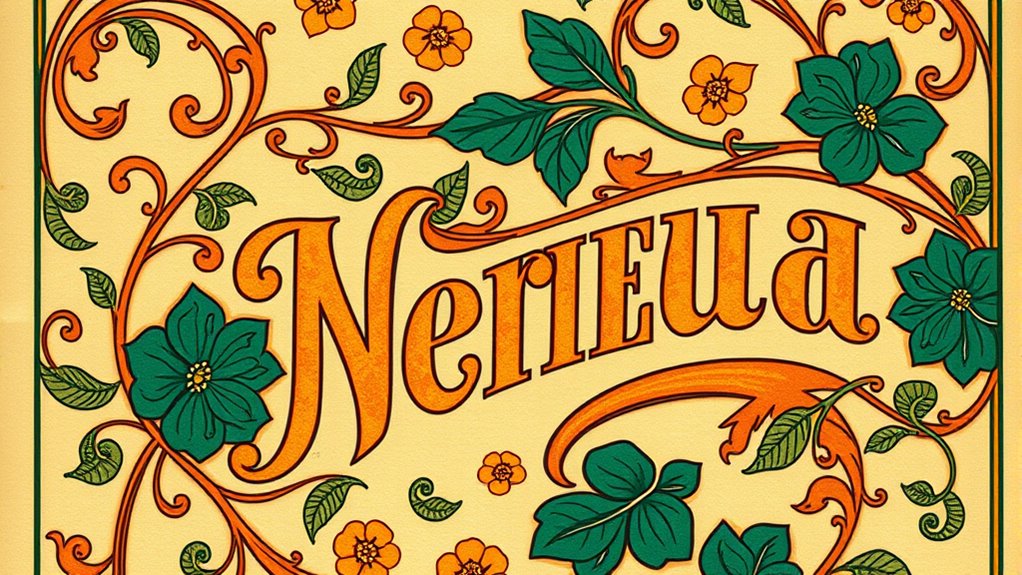
As a reaction against the industrialization and mass production of the late 19th century, the Art Nouveau movement emerged to celebrate craftsmanship and ornamental beauty. You’ll notice it emphasizes flowing lines and organic forms, often inspired by nature. Ornamental motifs and floral patterns dominate its designs, creating intricate, decorative visuals that evoke a sense of harmony and elegance. Artists and designers focused on craftsmanship, blending fine art with applied arts to produce posters, textiles, and furniture that highlight beauty and craftsmanship. This movement rejects the stark simplicity of earlier styles, instead embracing elaborate detail and natural inspiration. By emphasizing decorative design, Art Nouveau aimed to elevate everyday objects into works of art, fostering a new appreciation for beauty and ornamentation in graphic design. Additionally, the movement’s emphasis on craftsmanship contributed to the development of detailed and high-quality design standards. Its focus on natural inspiration helped redefine the relationship between art and functional objects, encouraging designers to incorporate more artistic elements into utilitarian items. Furthermore, the emphasis on ornamental detail played a key role in shaping modern design aesthetics by promoting a harmonious blend of beauty and utility. Embracing artistic innovation, the movement also pushed boundaries in how decorative arts integrated with industrial techniques.
The Bauhaus School and Modernist Principles in Graphic Art
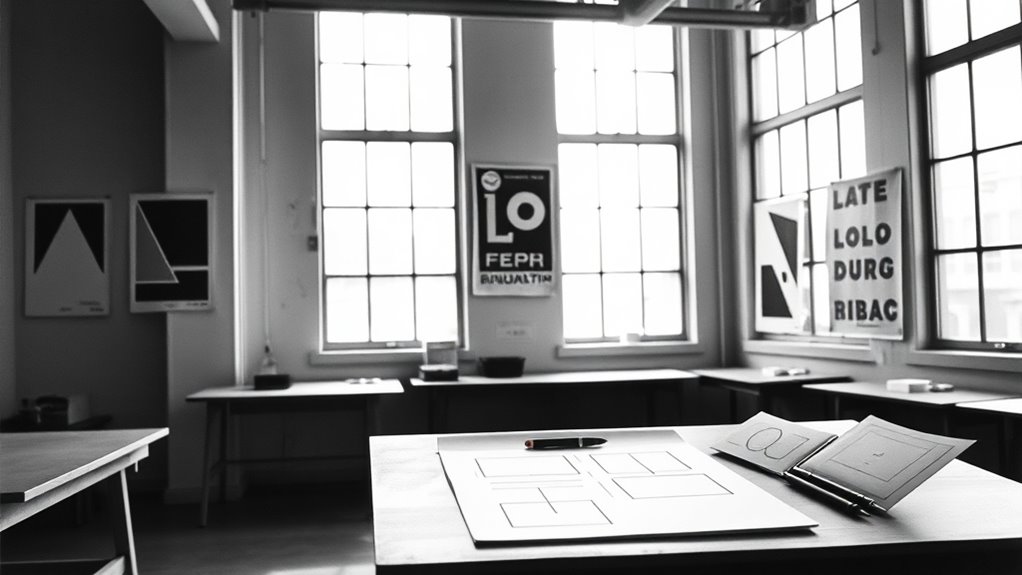
Founded in 1919, the Bauhaus School revolutionized graphic design by integrating art, craft, and technology through its modernist principles. Its influence transformed visual communication by emphasizing simplicity, functionality, and clarity—core aspects of modernist aesthetics. You see the Bauhaus influence in bold, geometric forms, sans-serif typefaces, and grid-based layouts that prioritize readability. The school’s approach encouraged designers to break free from ornate decoration, focusing instead on essential elements. This shift allowed for more universal, accessible designs that could be reproduced easily and efficiently. Additionally, the Bauhaus’s commitment to design education fostered a new generation of designers who adopted its emphasis on minimalism, symmetry, and the seamless integration of form and function, shaping contemporary graphic art. The movement’s emphasis on visual hierarchy and the use of grid systems remains foundational in modern design principles today. Moreover, the Bauhaus’s innovative use of typography set new standards for legibility and aesthetic balance in graphic communication. The principles established by the Bauhaus continue to influence modern design practices across various visual media, with an emphasis on universal accessibility.
The Development of Commercial Typography and Logo Design
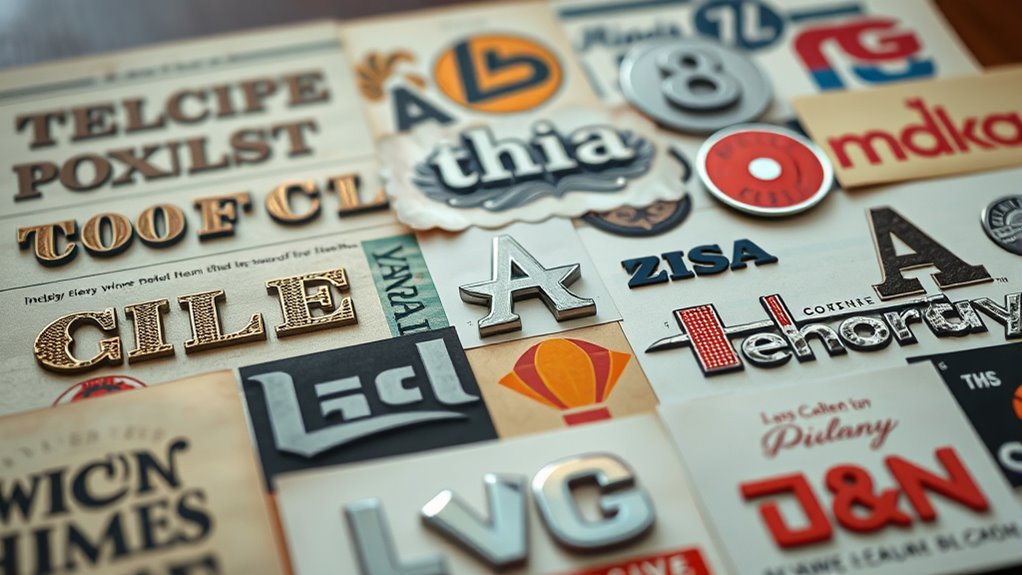
You’ll see how typefaces have evolved from ornate to sleek, functional styles that shape brand identities. Iconic logos have transformed marketing, becoming symbols that communicate instantly. Understanding these developments reveals how commercial design captures attention and builds recognition. Additionally, the strategic use of brand recognition in branding campaigns can foster a deeper emotional connection with audiences. Recognizing the importance of font selection helps designers craft visual identities that resonate and stand out in competitive markets. Furthermore, advances in material choices, such as eco-friendly ceramics and recycled products, have influenced the aesthetic and sustainability of graphic design branding elements.
Evolution of Typeface Styles
Have you ever wondered how commercial typography and logo design have evolved over time? The calligraphic evolution transitioned from ornate scripts to cleaner, more functional styles. Serif fonts, with their decorative strokes, became popular for print, conveying tradition and authority. In contrast, sans serif typefaces emerged as modern, minimal, and versatile options suited for digital environments. Additionally, the development of font styles reflects the broader trends in graphic design evolution, emphasizing readability and adaptability.
Iconic Logo Innovations
Iconic logo innovations have transformed the way brands communicate their identity and values. You see this in the bold use of abstract expressionism, where dynamic shapes and spontaneous brushstrokes evoke emotion and recognition. Surrealist motifs also influence logo design, introducing unexpected elements that challenge perceptions and create memorable visuals. These artistic movements inspire designers to go beyond traditional typography, blending artistic experimentation with commercial needs. The development of logos now often incorporates abstract forms and surrealist imagery to stand out in crowded markets. Such innovations elevate logos from simple identifiers to powerful symbols that reflect a brand’s creativity and uniqueness. By embracing these styles, you can craft logos that evoke deeper emotional responses and leave lasting impressions. Additionally, understanding graphic design milestones helps inform contemporary branding strategies and fosters innovative visual storytelling, especially when integrating artistic movements into modern design practices.
The Digital Revolution and the Birth of Computer-Aided Design
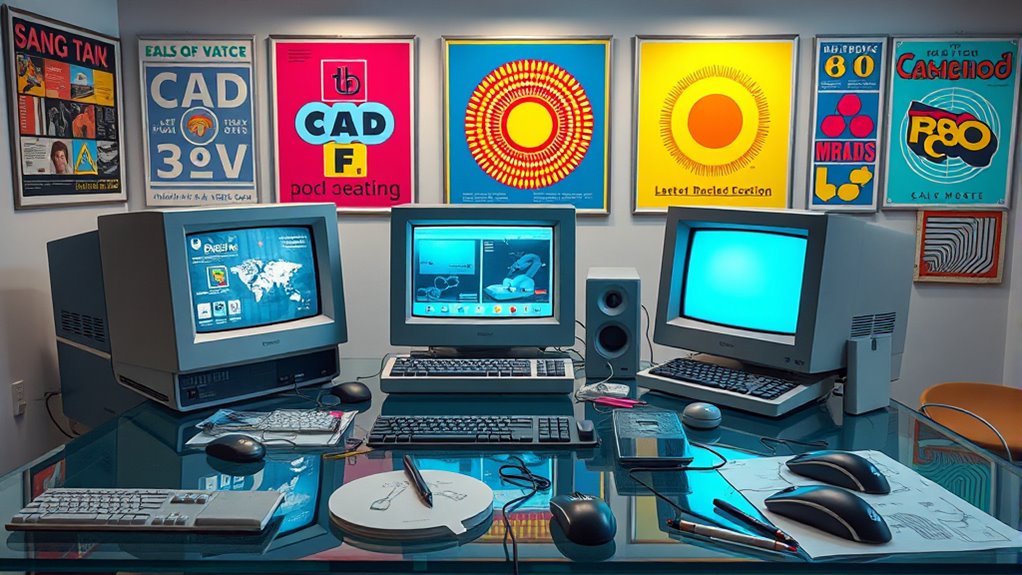
The digital revolution transformed graphic design by introducing powerful computer tools that streamline and enhance creative processes. You now have access to digital tools that make designing faster, more precise, and highly versatile. Software innovation, such as Adobe Photoshop and Illustrator, revolutionized how designers work, replacing manual techniques with digital methods. These programs allow you to experiment with colors, typography, and layouts easily, enabling quick adjustments and iterations. The shift to digital workflows also improved collaboration, as files can be shared instantly across distances. As a result, your creative possibilities expanded profoundly, making complex designs achievable in less time. The advent of computer-aided design marked a pivotal milestone, setting the stage for modern graphic design’s dynamic and innovative landscape. digital tools have also enabled the development of new design styles and techniques that continue to evolve today. Additionally, the integration of copyright regulations has influenced how designers approach legal and contractual issues related to intellectual property and licensing in digital projects, emphasizing the importance of understanding intellectual property rights in the digital age.
The Rise of Branding and Visual Identity Systems
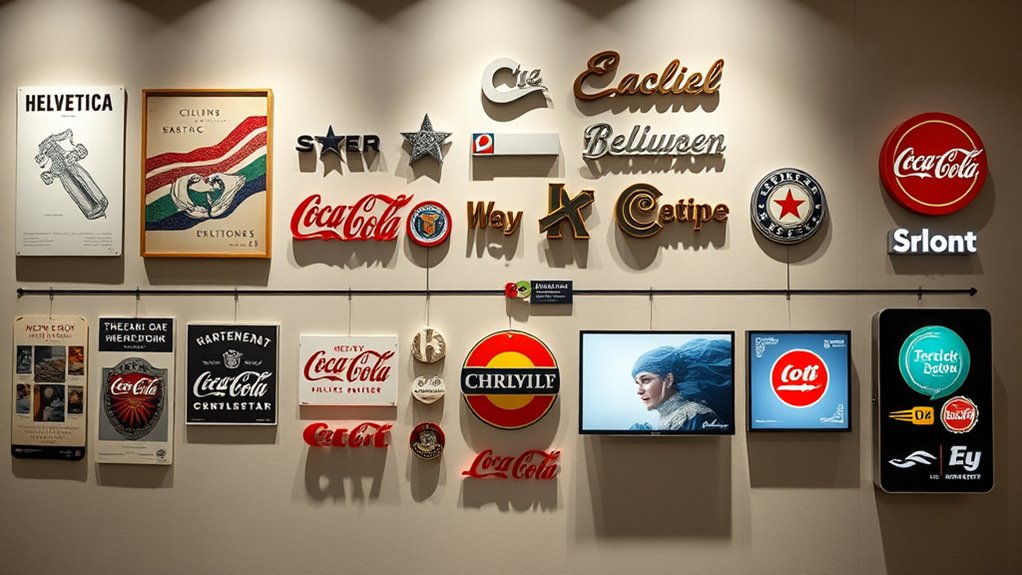
You notice how logos have evolved from simple symbols to powerful brand identifiers. Consistency in design helps brands build recognition and trust over time. This shift marks a significant step in how companies communicate their identity visually.
Corporate Logo Evolution
How did brands transform simple symbols into powerful tools for identity? They evolved through strategic use of abstract symbolism and color psychology, shaping memorable visual identities. Logos shifted from literal images to minimalistic marks that evoke emotion and recognition. This evolution allowed brands to communicate values instantly. Consider how color influences perception—blue conveys trust, red evokes excitement, and green suggests growth. The following table highlights key milestones:
| Year | Logo Style | Key Feature | Impact |
|---|---|---|---|
| 1950s | Simplified symbols | Abstract forms | Increased recognition |
| 1980s | Minimalism | Clean lines and limited palette | Modern appeal |
| 2000s | Dynamic logos | Adaptability across media | Broader brand reach |
| 2010s | Flat design | Reduced complexity | Enhanced digital presence |
| 2020s | Responsive logos | Scalable and versatile | Seamless across platforms |
This progression underscores how branding harnesses visual evolution to forge identity and emotional connection, with visual identity systems playing a crucial role in this transformation. Additionally, the use of brand consistency has become essential in maintaining recognition across various touchpoints.
Consistency in Design
As brands expanded their reach in the digital age, maintaining visual consistency became essential for building recognition and trust. Visual consistency ensures that your branding elements—colors, logos, typography—work together to create a cohesive identity. This consistency fosters branding harmony, making your brand instantly recognizable across various platforms and touchpoints. When your visual identity remains uniform, it strengthens brand recall and signals professionalism to your audience. You should develop clear guidelines to keep your branding elements aligned, avoiding mixed messages or confusing visuals. Consistency isn’t just about aesthetics; it’s about reinforcing your brand’s core values and personality. By prioritizing visual consistency, you create a unified experience that resonates with your audience and builds long-term loyalty. Resources available in multiple formats (books, online) support the implementation of effective branding standards.
The Emergence of User Interface and Web Design
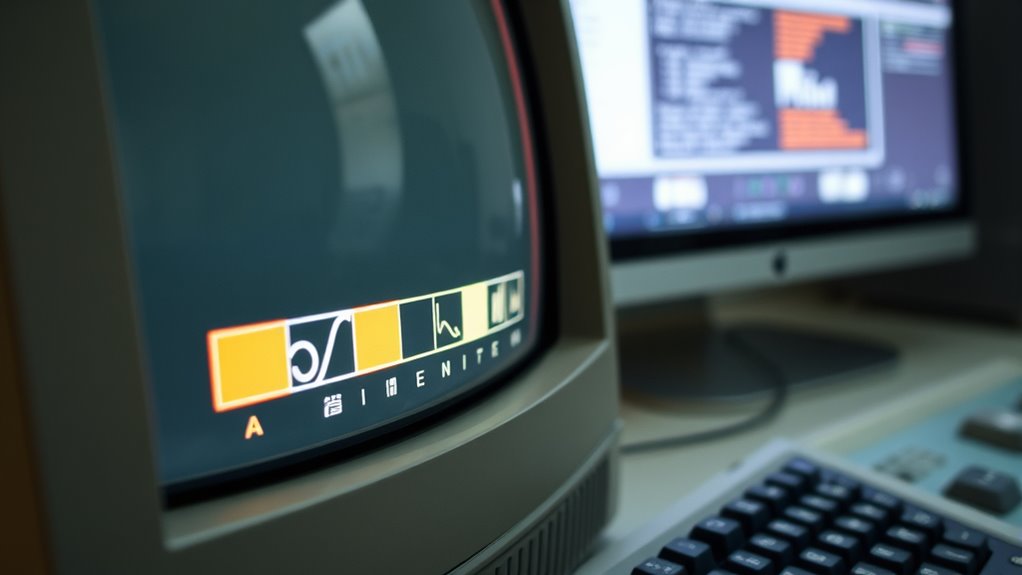
The emergence of user interface (UI) and web design transformed graphic design by making digital interactions more intuitive and engaging. You now focus on creating interactive interfaces that prioritize user experience, ensuring that every click and swipe feels seamless. This shift led to visually appealing layouts, intuitive navigation, and responsive designs that adapt to various devices. As a result, digital platforms became more accessible and user-friendly, encouraging longer engagement. You see web design evolve from simple text and graphics to dynamic, interactive environments. This change empowers you to craft experiences that guide users effortlessly through content and functions, blending aesthetics with functionality. The focus on user experience and interactive interfaces revolutionized how people connect with digital spaces.
- Visually appealing layouts that draw users in
- Responsive designs for various devices
- Seamless, intuitive navigation experiences
The Impact of Social Media and Mobile Graphics on Visual Culture

Social media has accelerated visual trends, making quick, impactful graphics essential for engagement. With mobile-first design, you now prioritize simplicity and accessibility for smaller screens. These shifts reflect broader cultural changes, transforming how society perceives and creates visual content.
Social Media Visual Trends
Have you ever wondered how social media and mobile devices have transformed visual culture? They’ve shifted how we communicate, emphasizing quick, engaging visuals. You now see a focus on emoji expression, which adds emotion and personality instantly. The color palette has become more vibrant and diverse to catch attention on small screens.
- Bright, bold colors dominate feeds, making content stand out.
- Minimalist, clean designs help messages become clearer.
- User-generated visuals, like memes and stories, shape current trends.
These elements reflect a move toward immediacy and relatability, driven by social media’s demand for eye-catching, shareable content. The influence of emoji expression and dynamic color palettes creates a visual language that’s playful, personal, and constantly evolving.
Mobile-First Design Focus
How has the rise of mobile devices reshaped design priorities? You now focus on creating experiences optimized for small screens through viewport scaling and responsive typography. Designers prioritize flexible layouts that adapt seamlessly across devices, ensuring content remains clear and engaging. Mobile-first design shifts your attention from desktop to mobile, emphasizing quick load times and touch-friendly interfaces. You understand that visual elements must scale appropriately, maintaining readability without sacrificing aesthetic appeal. This approach influences typography choices, ensuring fonts resize fluidly for different viewports. As social media and mobile graphics dominate, your goal is to craft visuals that captivate users instantly, regardless of device. This focus on mobile-first principles transforms how you approach layout, interaction, and overall visual communication.
Cultural Shifts in Graphics
The rise of social media and mobile graphics has fundamentally transformed visual culture, shaping the way you create and interpret images today. You now see cultural symbolism packed into small icons, memes, and hashtags that communicate complex ideas instantly. Visual storytelling has become faster and more accessible, often relying on quick, impactful visuals to convey messages. These shifts mean your visuals are more than just aesthetic; they carry cultural meaning and values.
- You use symbols that resonate globally, transcending language barriers.
- You craft images that tell stories within seconds, engaging audiences instantly.
- Cultural symbolism influences design choices, shaping perceptions and shared identities.
This evolution impacts how you interpret images, making visual communication more dynamic, personal, and culturally layered than ever before.
The Future of Graphic Design: Trends and Technologies

As technology continues to advance at a rapid pace, graphic design is poised to undergo significant transformations driven by emerging trends and innovations. Augmented reality will become more integrated into everyday experiences, allowing you to create interactive, immersive designs that blend digital and physical worlds seamlessly. Generative art will empower you to craft complex, unique visuals through algorithms, enabling more personalized and dynamic content. These technologies will push the boundaries of creativity, making designs more engaging and versatile. You’ll find new tools that foster experimentation and rapid iteration, enhancing productivity and innovation. As a result, the future of graphic design promises more immersive storytelling, hyper-personalization, and smarter design processes that adapt to user needs in real time.
Frequently Asked Questions
How Did Early Cultures Develop Visual Storytelling Techniques?
You see that early cultures developed visual storytelling techniques through symbolic communication and narrative imagery. They used symbols, images, and patterns to convey stories, beliefs, and traditions before written language. By creating illustrations and carvings, they made stories accessible to their communities. These methods helped preserve their history, culture, and values, establishing a foundation for modern graphic design. Your understanding of this shows how powerful visual storytelling can be across time.
What Influences Shaped the Transition From Print to Digital Design?
Imagine your design journey as sailing from solid land to a vibrant digital sea. The shift was fueled by the typography evolution, making text more adaptable and expressive, and color palette shifts, offering endless hues to evoke emotion. Technological advances like computers and software acted as your compass, guiding you through this progression. Now, you navigate a dynamic landscape where creativity seamlessly flows from print to digital, expanding your design horizons.
How Did Graphic Design Influence Political Movements Historically?
You see how graphic design has historically shaped political movements through propaganda posters and political iconography. You recognize that powerful visuals, slogans, and symbols communicate messages quickly and emotionally, rallying support or opposition. By using striking imagery and consistent themes, designers influence public opinion, mobilize communities, and create memorable symbols that endure. This visual language becomes a essential tool in shaping political discourse and inspiring collective action throughout history.
What Role Did Technology Play in the Evolution of Corporate Branding?
You see technology transforming corporate branding through digital innovation, branding psychology, and visual consistency. Digital tools allow you to craft memorable logos, engaging websites, and dynamic social media campaigns, all emphasizing branding psychology to connect emotionally with your audience. As you leverage these technological advances, you create a cohesive brand identity that resonates, adapts, and stands out in an ever-evolving digital landscape, making your brand more recognizable and impactful.
How Might Future Technologies Transform Graphic Design Practices?
Future technologies like Augmented Reality and AI Creativity will revolutionize your graphic design practices. You’ll be able to create immersive, interactive experiences that engage your audience in new ways. AI tools will enhance your creativity, offering smarter suggestions and automating repetitive tasks. As these technologies develop, you’ll adapt your skills, pushing boundaries and crafting dynamic visuals that blend digital innovation with artistic expression for more impactful communication.
Conclusion
As you explore these milestones, you’ll see how graphic design constantly evolves, shaping how we communicate visually. Did you know that by 2023, over 4.9 billion people worldwide use social media, making visual content more crucial than ever? Embracing these shifts, you can stay ahead in a field that transforms with technology and culture. Keep pushing boundaries, and you’ll help craft the future of visual storytelling.
